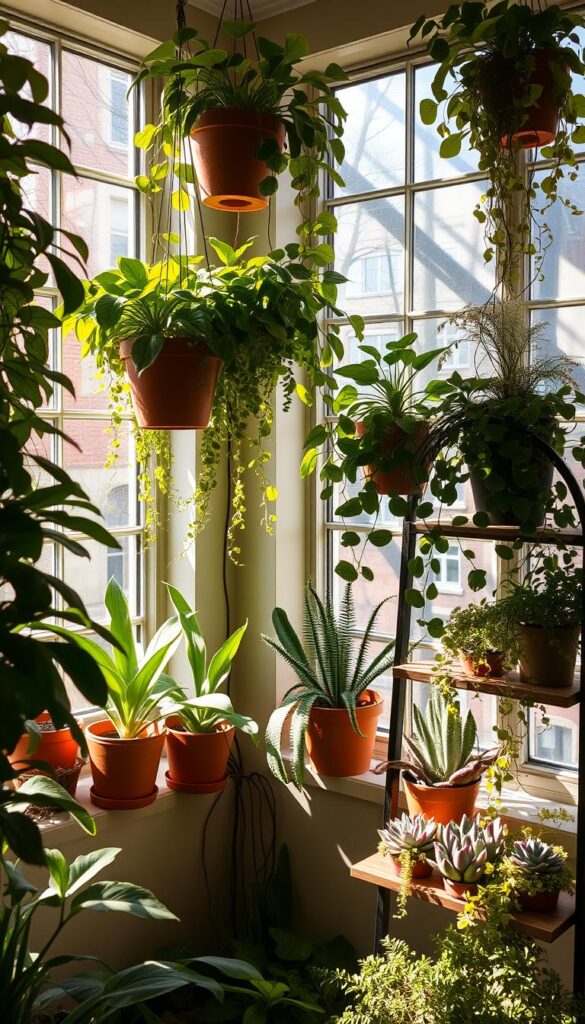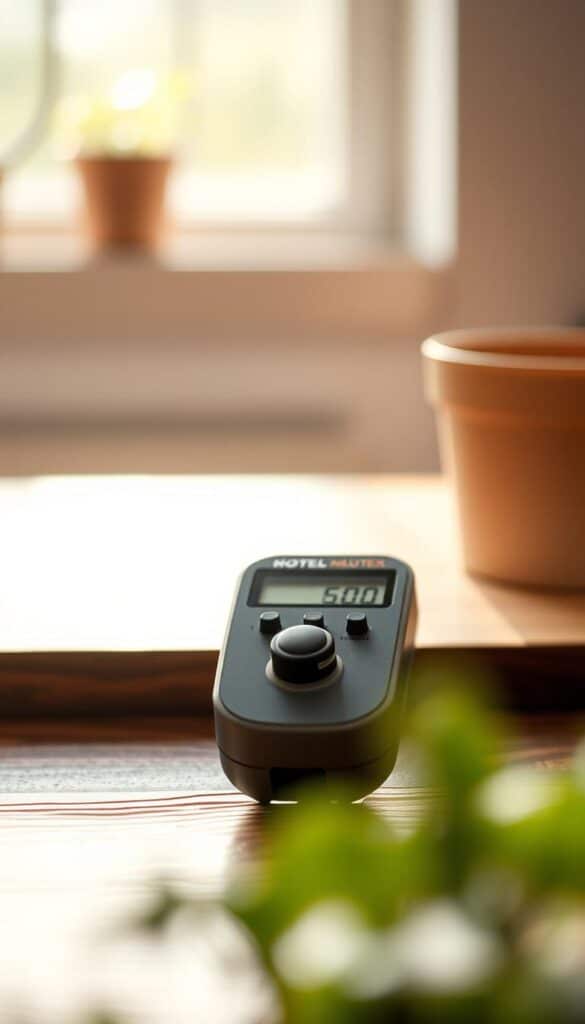Welcome to the world of indoor gardening! My journey into transforming my home with plants began with a few small pots and a lot of curiosity. Today, I’m excited to share clever shortcuts that have turned my space into a lush oasis. Did you know that 66% of U.S. consumers now own at least one houseplant? This surge in popularity isn’t surprising—plants have a way of bringing life and tranquility into our homes.
Simple adjustments can make a big difference. For instance, using ice cubes to water your plants slowly or incorporating natural nutrients like coffee grounds can enhance their health. These smart hacks are not just practical but also sustainable, making them perfect for eco-conscious plant lovers.
Whether you’re a seasoned gardener or just starting out, these tips are designed to boost your confidence and creativity. Every hack shared here is backed by real-life examples and expert advice, ensuring you get the best results. So, let’s dive in and explore how these simple tricks can transform your indoor space into a thriving sanctuary.
Indoor Plant Hacks: Innovative Watering Techniques
Discover innovative ways to water your plants efficiently without making a mess. These creative methods will help you maintain the perfect moisture levels and keep your plants thriving.
Using Ice Cubes for Slow Moisture Release
One clever tip is to use ice cubes. This method ensures a slow release of moisture, preventing overwatering. It’s especially useful for busy people who want to maintain the right moisture levels without constant monitoring.
By placing an ice cube in the soil, you allow the water to release gradually as it melts. This technique helps maintain balanced moisture levels and prevents water from spilling over.
Gathering and Utilizing Rainwater
Gathering rainwater is another sustainable option. Rainwater is naturally pure and contains nutrients that are beneficial for plants. Start by collecting rainwater in a clean container during a downpour.
Before using rainwater, let it sit for a day to allow any sediment to settle. This ensures it’s safe and effective for your plants.
| Watering Method | Benefits | Tips |
|---|---|---|
| Ice Cubes | Slow moisture release, reduces mess | Perfect for busy schedules |
| Rainwater | Natural purity, added nutrients | Collect during rain, let settle before use |
These strategies promote a hands-on yet low-maintenance approach. By applying these simple tips, you can enjoy improved plant health and a cleaner indoor space, making it ideal for anyone short on time.
Creative Plant Placement for Maximum Light
Strategic plant placement can transform your home into a bright, inviting space. By balancing sun and shade, you create an environment where your plants thrive and your interior looks stunning. Thoughtful placement ensures each plant gets just the right amount of light while maintaining essential nutrients.
Balancing Sun and Shade with Furniture Placement
Using furniture to section off areas with different light levels is a clever trick. For example, placing a tall bookshelf near a sunny window creates shade for plants that prefer less light. This not only optimizes light distribution but also enhances the room’s ambiance and air quality.
Optimizing Your Living Space Layout
Positioning plants to absorb the right amount of natural light is key. I always make sure each plant is placed where it can receive adequate sunlight without overexposure. This balance ensures they maintain their nutrients and stay healthy.

By optimizing your layout, you can create a space that’s both functional and visually appealing. A little planning can turn your home into a natural oasis, enhancing its vibe and making it a beautiful place to live.
Turning Coffee Grounds into Plant Nutrients
One of the most surprising sources I’ve discovered for enhancing my indoor plants is coffee grounds. This simple, everyday waste material has become a valuable asset for my potting soil, providing natural nutrients that promote healthy growth throughout the year.
Enhancing Soil Nutrients Naturally
I learned about this hack from Dolores Koland, who swears by coffee grounds for her thriving houseplants. The science behind it is straightforward: coffee grounds are rich in nitrogen, phosphorus, and potassium, which are essential for plant growth. These nutrients help strengthen the roots and encourage robust development.
To incorporate coffee grounds into your potting soil, start by mixing one to two tablespoons into the top layer. This method ensures a steady release of nutrients without overwhelming the plant. Plus, this natural thing reduces waste and supports an eco-friendly approach to plant care.
| Benefits | Tips | Eco-Friendly Aspect |
|---|---|---|
| Rich in essential nutrients | Mix 1-2 tablespoons into soil | Reduces kitchen waste |
| Supports healthy root growth | Let grounds cool before mixing | Encourages sustainable gardening |
| Improves soil structure | Use consistently for best results | Provides a natural fertilizer source |
Remember, always allow coffee grounds to cool before mixing them into your potting soil to avoid harming your plants. This simple, eco-friendly hack is a great way to give your indoor plants a nutrient boost while reducing waste. It’s a win-win for both your plants and the environment!
Using a Soil Moisture Meter to Perfectly Time Watering
When it comes to watering your plants, precision is key. Overwatering can be harmful, while underwatering can stress your plants. This is where a soil moisture meter comes into play, offering a smart solution to ensure your plants receive just the right amount of water.
How a Moisture Meter Works
A soil moisture meter is a simple, tech-savvy tool that measures the moisture levels in your soil. By inserting the probe into the soil, the meter interprets the moisture content and displays it on a scale. This helps you determine whether the soil is wet, moist, or dry, making it easier to decide when to water.
Tips to Avoid Overwatering
To get the most out of your soil moisture meter, follow these tips:
| Feature | Benefit | Tips |
|---|---|---|
| Moisture Reading | Accurate Water Level Detection | Insert probe 2-3 inches deep for precise readings |
| Visual Scale | Easy-to-Understand Results | Check readings before and after watering |
| Portability | Convenient for Multiple Plants | Use for all plants to ensure balanced watering |
Using a soil moisture meter not only saves time but also ensures your plants thrive. It’s a modern, efficient way to maintain the perfect balance of water in your garden, leading to healthier roots and a more vibrant home space.

Rotate Your Houseplants for Even Sun Exposure
Keeping your houseplants healthy and balanced is easier than you think. One simple yet effective practice is rotating them regularly. This ensures they get even sun exposure, preventing lopsided growth and promoting a fuller appearance.
Benefits of Regular Plant Rotation
Judy Roberts, a seasoned gardener, shared a valuable tip: rotating plants once a week. This habit not only balances their structure but also enhances their overall health. I adopted this practice by giving my plants a quarter-turn each week, and the improvement in their symmetry was noticeable.
- Regular rotation acts like a natural fertilizer, ensuring all sides receive equal light and moisture from the surrounding grounds.
- Expert tip: Consistent rotation improves air circulation, reducing plant stress and promoting healthier growth.
- Even small adjustments in daily habits can boost humidity levels around plants, fostering a more nurturing environment.
By incorporating these simple rotation techniques, you can create a balanced, thriving indoor space that feels like a natural oasis. It’s a small change that makes a big difference in the health and appearance of your plants.
Boosting Plant Growth with Natural Fertilizers
Natural fertilizers can work wonders for your plants, and I’ve found a couple of methods that really make a difference. Whether you’re a seasoned gardener or just starting out, these simple tricks can give your plants the nutrients they need to thrive.
Applying the 10-10-10 Fertilizer Rule
A balanced fertilizer like 10-10-10 provides equal amounts of nitrogen, phosphorus, and potassium. This mix is perfect for promoting healthy growth and vibrant blooms. I use it sparingly during the growing season to give my plants a nutrient boost without overloading the soil.
Leveraging Eggs and Other Organic Nutrients
Eggs are another surprising source of nutrients for your plants. After boiling eggs, I let the water cool and then use it to water my plants. The calcium and minerals from the eggs help strengthen the roots and promote blooming. It’s a simple, eco-friendly way to give your plants a little extra care.
| Fertilizer Type | Benefits | Tips |
|---|---|---|
| 10-10-10 Balanced Fertilizer | Promotes healthy growth and vibrant blooms | Use during the growing season for best results |
| Egg Water | Rich in calcium and minerals | Let water cool before applying to soil |
By combining these natural fertilizers with proper drainage, you can create a nurturing environment for your plants. Even small adjustments can lead to big improvements, so don’t hesitate to experiment and find what works best for your indoor space.
Selecting Small Houseplants for Compact Indoor Spaces
Even in the tiniest rooms, you can create a lush oasis. I’ve found that small houseplants are perfect for enhancing compact areas without taking up too much space. These plants not only fit neatly on narrow window sills but also bring life and beauty to any corner.
Top Space-Saving Plant Picks
When it comes to small spaces, certain plants stand out. Haworthia succulents and Peperomia are my favorites. Both have low soil moisture needs and thrive in limited space, making them ideal for small pots and tight spots.
- Haworthia succulents are perfect for tiny pots and require minimal care.
- Peperomia adapts well to low-light conditions, making it great for rooms with limited natural light.
These plants are not just space-efficient but also add a touch of greenery to any compact area.
Choosing the Right Pot and Soil
Selecting the right pot and soil is crucial for small plants. Look for pots with good drainage to prevent waterlogged soil. The pot’s bottom should have holes to ensure excess water can escape, maintaining healthy soil moisture levels.
The size of the pot matters too. A 3-inch pot is ideal for narrow window sills, providing enough space for the plant’s roots without overcrowding. Pair this with a well-draining soil mix to create the perfect environment for your plants.
| Plant | Benefits | Best Pot Size |
|---|---|---|
| Haworthia | Low maintenance, small footprint | 3-inch pot |
| Peperomia | Adaptable, fits tight spaces | 3-inch pot |
By choosing the right plants, pots, and soil, you can create a dynamic, clutter-free indoor garden. Finding the perfect link between style and function is key to making the most of your small space.
Wrapping Up: My Personal Journey to a Greener Home
Reflecting on my journey to a greener home, I’ve discovered how small, thoughtful changes can create a vibrant oasis. By implementing these simple strategies, I’ve transformed my space into a thriving environment where every inch counts and every decision matters.
One of the most impactful lessons I’ve learned is the power of detail. Adjusting just an inch in plant placement or enhancing top soil quality can resolve common problems and elevate plant health. These tweaks, inspired by expert advice from Birds & Blooms and stories from fellow plant enthusiasts, have been game-changers.
Adhering to a few key policies—like consistent care routines and mindful space planning—has helped me overcome challenges. I encourage you to explore these hacks with an open mind, embracing sustainable practices that nurture both your plants and the planet.
Take a step toward a lush, thoughtfully arranged home. Even the smallest adjustment can lead to big improvements, proving that a greener, more vibrant space is within reach for everyone.
